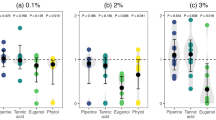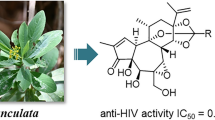Abstract
Adults of the longhorned beetle, Chloridolum loochooanum Gressitt (Coleoptera: Cerambycidae) emit a white frothy secretion from their metasternal glands. This defensive substance contains cyclopentanoid monoterpenoids (iridodials), whose structures were elucidated by gas chromatography-mass spectrometry (GC-MS) and nuclear magnetic resonance (NMR) analyses that compared the naturally occurring structures with synthesized versions. Optically active citronellals, [(S)-, (R)-, and (S)/(R)- mixture], were used as starting materials for synthesizing the corresponding iridodials for the determination of the absolute configuration of the natural product. The retention time of (2S)-iridodial, derived from (S)-citronellal, corresponded to that of C. loochooanum iridodial by enantioselective GC analysis. Thus, we suggest that the absolute configuration of C. loochooanum iridodial is (1R,2S,5S)-iridodial.





Similar content being viewed by others
References
Allison, J. D., Borden, J. H., and Seybold, S. J. 2004. A review of the chemical ecology of the Cerambycidae (Coleoptera). Chemoecology 14:123–150.
Attygalle, A. B., and Morgan, E. D. 1984. Chemicals from the glands of ants. Chem. Soc. Rev. 13:245–278.
Balestrazzi, E., Dazzini, M. L. V., de Bernardi, M., Vidari, G., Vita-finzi, P., and Mellerio, G. 1985. Morphological and chemical studies on the pygidial defense glands of some Carabidae (Coleoptera). Naturwissenschaften 72:482–484.
Birkett, M. A., and Pickett, J. A. 2003. Aphid sex pheromones: From discovery to commercial production. Phytochemistry 62:651–656.
Burse, A., Schmidt, A., Frick, S., Kuhn, J., Gershenzon, J., and Boland, W. 2007. Iridoid biosynthesis in Chrysomelia larvae: Fat body produces early terpenoid precursors. Insect Biochem. Mol. Biol. 37:255–265.
Cavill, G. W. K., and Hinterberger, H. 1961. Chemistry of ants. 5. Structure and reactions of dolichodial. Aust. J. Chem. 14:143–149.
Cavill, G. W. K., and Houghton, E. 1974. Volatile constituents of the Argentine ant, Iridomyrmex humilis. J. Insect Physiol. 20:2049–2059.
Chapman, R. F. 1998. The Insects. Cambridge University Press, UK, p. 770.
Chauhan, K. R., Zhang, Q. -H., and Aldrich, J. R. 2004. Iridodials: Enantiospecific synthesis and stereochemical assignment of the pheromone for the golden-eyed lacewing, Chrysopa oculata. Tetrahedron Lett. 45:3339–3340.
Clark, K. J., Fray, G. I., Jaeger, R. H., and Robinson, R. 1959. Synthesis of d- and l-isoiridomyrmecin and related components. Tetrahedron 6:217–224.
Constantino, M. G., and da Silva, G. V. J. 1998. Stereochemistry in substituted cyclopentanes: An approach to the analysis by proton NMR. Tetrahedron 54:11363–11374.
Do nascimento, R. R., Billen, J., Sant’ana, A. E. G., Morgan, E. D., and Harada, A. Y. 1998. Pygidial gland of Azteca NR. bicolor and Azteca chartifex: Morphology and chemical identification of volatile components. J. Chem. Ecol. 24:1629–1637.
Dossey, A. T., Walse, S. S., and Edison, A. S. 2008. Developement and geographical variation in the chemical defense of the walkingstick insect Anisomorpha buprestoides. J. Chem. Ecol. 34:584–590.
Eisner, T., Jones, T. H., Aneshansley, D. J., Tschinkel, W. R., Silberglied, R. E., and Meinwald, J. 1977. Chemistry of defensive secretion of bombardier beetles (Brachinini, Metriini, Ozaenini, Paussini). J. Insect Physiol. 23:1383–1386.
Eisner, T., Eisner, M., Aneshansley, D. J., Wu, C.-L., and Meinwald, J. 2000. Chemical defense of the mint plant, Teucrium marum (Labiatae). Chemoecology 10:211–216.
Fukaya, M., Yasuda, T., Wakamura, S., and Honda, H. 1996. Reproductive biology of the yellow-spotted longicorn beetle, Psacothea hilaris (Pascoe) (Coleoptera: Cerambycidae). III. Identification of contact sex pheromone on female body surface. J. Chem. Ecol. 22:259–270.
Gressit, J. L. 1933. New longicorns from the Japan Empire (Coleopt., Cerambycidae). Pan-Pac. Entomol. 9:163–170.
Helfrich, E., and Rimpler, H. 2000. Iridoid glycosides from Gmelina philippensis. Phytochemistry 54:191–199.
Huth, A., and Dettner, K. 1990. Defense chemicals from abdominal glands of 13 rove beetle species of subtribe Staphylinina (Coleoptera: Staphylinidae, Staphylininae). J. Chem. Ecol. 16:2691–2711.
Kanehisa, K., and Kawazu, K. 1985. Differences in neutral components of the defensive secretion in formic acid-secreting carabid beetles. Appl. Ent. Zool. 20:299–304.
Kojima, K., and Hayashi, M. 1969. Longicorn beetles. Insects’ Life in Japan I. 294 pp. Hoikusha.
Laurent, P., Braekman, J.-C., and Daloze, D. 2005. Insect chemical defense. Top. Curr. Chem. 240:167–229.
Makihara, H. 2003. On the geographic variation of cerambycid beetles (Coleoptera; Cerambyciae)—Chlorophorus quinquefasciatus. The Nature and Insects 38:30–32.
Makihara, H. 2005. A new subspecies of Chloridolum loochooanum (Coleoptera, Cerambycidae) from Okinawa Island of the Nansei Islands, southwest Japan. Elytra 33:121–125.
Makihara, H., and Ohmura, W. 2005. A longicorn beetle, Chloridolum loochooanum, emits ‘smell’ during flying. Kouchu-News 150:14.
Markarian, H., Florentine, G. J., and Pratt, J. J. Jr. 1978. Quinone production of some species of Tribolium. J. Insect Physiol. 24:785–790.
Mcgurk, D. J., Frost, J., Waller, G. R., Eisenbraun, E. J., Vick, K., Drew, W. A., and Young, J. 1968. Iridodial isomers variation in Dolichoderine ants. J. Insect Physiol. 14:841–845.
Meinwald, J., Chadha, M. S., Hurst, J. J., and Eisner, T. 1962. Defense mechanisms of arthropods. 9. Anisomorphal, the secretion of a phasmid insect. Tett. Letters 1962:29–33.
Meinwald, J., Jones, T. H., Eisner, T., and Hick, K. 1977. New methylcyclopentanoid terpenes from the larval defensive secretion of a chrosomelid beetle (Plagiodera versicolora). Proc. Natl. Acad. Sci. USA 74:2189–2193.
Moore, B. P., and Brown, W. V. 1972. The chemistry of the metasternal gland secretion of the common eucalypt longicorn, Phoracantha semipunctata (Coleoptera: Cerambycidae). Aust. J. Chem. 25:591–598.
Moore, B. P., and Brown, W. V. 1976. The chemistry of the metasternal gland secretion of the eucalypt longicorn, Phoracantha synonyma (Coleoptera: Cerambycidae). Aust. J. Chem. 29:1365–1374.
Murai, F., and Tagawa, M. 1982. 8-Epi-iridodial glucoside from Boschniakia rossica. Planta Med. 46:45–47.
Murai, F., and Tagawa, M. 1994. Chemistry on iridoid monoterpenes and the glycosides from Actinidia polygama—Iridodialogentiobioside as the precursor. Koryo 182:73–84.
Murai, F., and Tagawa, M. 1997. The functional roles of iridoid and ionone type glycosides in the attractive and ecstasizing plants for felids. Food and Food Ingredients J. of Jpn. 173:61–72.
Murai, F., Tagawa, M., Inouye, H., Ishida, T., and Inoue, M. 1987. A new iridoid glucoside, nepetariaside, from Nepeta cataria. Chem. Pharm. Bull. 35:2533–2537.
O’connor, B., and Just, G. 1987. A new method for conversion of aldehydes to methyl esters using pyridinium dichromate and methanol in dimethylformamide. Tetrahedron Lett. 28:3235–3236.
Oldham, N. J. 1994. Chemical studies on exocrine gland secretions and pheromones of some social insects. PhD thesis. Keele University, Keele, UK, 201 pp.
Regner, F. E. 1972. Semiochemicals, pp. 723–734, in G. R. Waller (ed.). Biochemical Applications of Mass SpectrometryWiley-Interscience, New York.
Sakai, T., Morita, K., Matsumura, C., Sudo, A., Tsuboi, S., and Takeda, A. 1981. Syntheses and 13C NMR spectra of trans,cis- and trans,trans-nepetalinic acids and photocitral A. J. Org. Chem. 46:4774–4779.
Schultz, G., Simbro, E., Belden, J., Zhu, J., and Coat, J. 2004. Catnip, Nepeta cataria (Lamiales: Lamiaceae)—A closer look: Seasonal occurrence of nepatalactone isomers and comparative repellency of three terpenoids to insects. Environ. Entomol. 33:1562–1569.
Smith, R. M., Brophy, J. J., Cavill, G. W. K., and Davies, N. W. 1979. Iridodials and nepetalactone in the defensive secretion of the coconut stick insects, Graeffea crouani. J. Chem. Ecol. 5:727–735.
Vidari, G., Bernandi, M. D., Pavan, M., and Ragozzino, L. 1973. Rose oxide and iridodial from Aromia moschata L. (Coleoptera: Cerambycidae). Tetrahedron Lett. 41:4065–4068.
Weibel, D. B., Oldham, N. J., Feld, B., Glombitza, G., Dettner, K., and Boland, W. 2001. Iridoid biosynthesis in staphylinid rove beetles (Coleoptera: Staphylinidae, Philonthinae). Insect Biochem. Mol. Biol. 31:583–591.
Zhang, Q. -H., Chauhan, K. R., Erbe, E. F., Vellore, A. R., and Aldrich, J. R. 2004. Semiochemistry of the golden lacewing Chrysopa oculata: Attraction of males to a male-produced pheromone. J. Chem. Ecol. 30:1849–1870.
Zhang, Q.-H., Schneidmiller, R. G., Hoover, D., Welshons, D., Young, K., Margaryan, A., Aldrich, J. R., and Chauhan, K. R. 2006a. Male-produced pheromone of the green lacewing Chrysopa nigricornis (Neuroptera: Chrysopidae). J. Chem. Ecol. 32:2163–2176.
Zhang, Q. -H., Sheng, M., Chen, G., Aldrich, J. R., and Chauhan, K. R. 2006b. Iridodial: a powerful attractant for the green lacewing, Chrysopa septempunctata (Neuroptera: Chrysopidae). Naturwissenschaften 93:461–465.
Acknowledgments
We thank Dr. Kamlesh R. Chauhan for donation of synthetic (1R,2S,5R,8R)-, and (1R,2S,5R,8S)-iridodials for comparison with C. loochooanum iridodials. We also thank Dr. Motoko Tagawa for valuable advice on this work. This work was supported in part by a Grant-in-Aid for Scientific Research (nos. 16780130, 19580197) from the Japan Society for the Promotion of Science.
Author information
Authors and Affiliations
Corresponding author
Rights and permissions
About this article
Cite this article
Ohmura, W., Hishiyama, S., Nakashima, T. et al. Chemical Composition of the Defensive Secretion of the Longhorned Beetle, Chloridolum loochooanum . J Chem Ecol 35, 250–255 (2009). https://doi.org/10.1007/s10886-009-9591-y
Received:
Revised:
Accepted:
Published:
Issue Date:
DOI: https://doi.org/10.1007/s10886-009-9591-y




